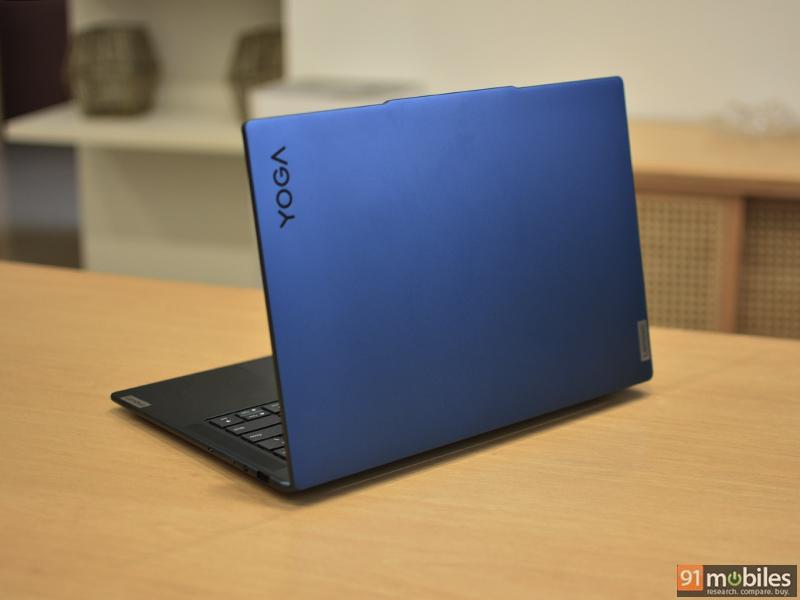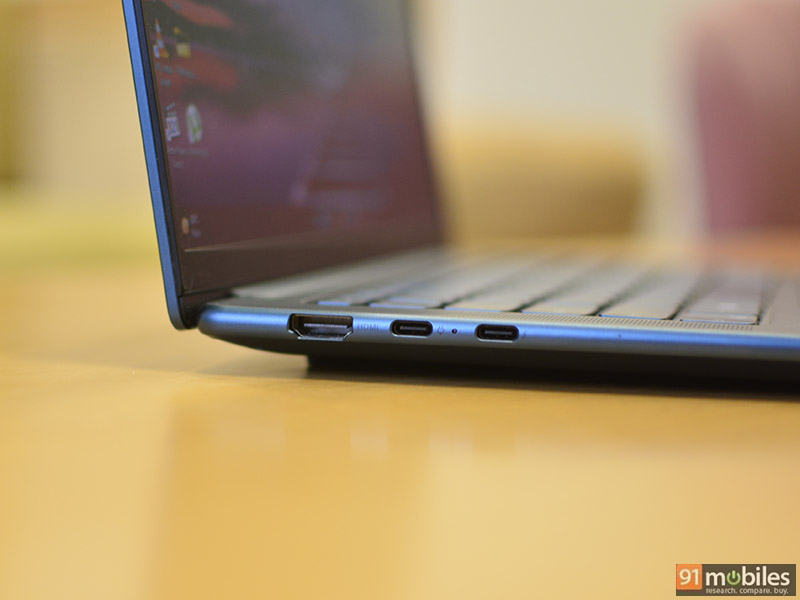Lenovo has a vast lineup of notebooks that cater to a variety of audiences. Its Yoga lineup this year is quite interesting, packing the latest hardware in a slim and lightweight design. One such product is the Yoga Pro 7i (previously called the Yoga Sim 7i Pro), which is primarily targeted at budding creators or someone who is looking for a sleek yet powerful laptop.

Design
Aesthetically the new Yoga Pro 7i looks a lot like the previous version, but you now get rounded edges which makes it much more comfortable to hold or carry around. Speaking of which, the laptop weighs just 1.5kgs. The lightweight aluminium chassis has a premium finish with a ‘Tidal Teal’ hue, which is basically a refined mixture of grey and blue that looks pleasing to the eye. The device is also claimed to meet MIL-STD 810H military-grade rugged standards, meaning it should be able to survive minor bumps and shocks.

The lid is quite sturdy and can open all the way up to 180-degrees and overall I didn’t feel the chassis creaking or flexing all that much. There is also an extended section in the middle of the top edge that helps in opening the lid quite easily. The new model also comes with a larger 14.5-inch display (replacing the previous 14-inch) gaining a 16:10 aspect ratio. More on that in the display section.

There is also an update in the I/O department as the laptop now comes with a dedicated HDMI 2.1 port alongside two USB Type-C ports, one of which supports Thunderbolt 4. There is also a headphone and mic combo jack and a USB 3.2 Gen 1 Type-A port. Like most of Lenovo’s premium notebooks, this one also comes with a dedicated switch to turn off the webcam next to the power button placed on the right edge.


At the bottom there is a ventilated section for air intake. Sadly I couldn’t open the bottom cover due to the Torx screws.

Display
As mentioned, the display has been upgraded which is not only bigger but sharper and more vibrant. Measuring at 14.5-inches diagonally, the LCD display comes with a 3K (3,072 x 1,920 pixels) resolution with a 120Hz refresh rate, 400-nits of peak brightness, 100 percent sRGB and DCI-P3 coverage along with additional TÜV low blue light and eyesafe certifications. Lenovo also claims a Delta E<1 for colour accuracy.

Despite the matte finish, I found the display to offer ample brightness although it seems to fall below 400 nits. Content looks very sharp and even the colours are vibrant and true to life in most scenarios. I really appreciate Lenovo for moving to 120Hz refresh rate which makes the entire experience on the laptop extremely smooth and satisfying.
While I didn’t find any special software to fine-tune the colours, there is an Eye Care Mode under the Lenovo Vantage software. This allows you to enable a warm tone that can be tuned using a slider. This can help in avoiding potential eye straining by reducing blue light.
Keyboard and trackpad
I’ve always appreciated Lenovo with their laptop keyboards and the Yoga Pro 7i doesn’t disappoint. You don’t get a dedicated numpad, but you do get the familiar keys with rounded bottoms. Typing felt fast and accurate on the keyboard thanks to a good amount of travel and feedback. The keys also come with white backlighting where you can adjust the brightness or by pressing the Fn + Spacebar keys. There’s also an Auto function where the system can enable backlight automatically depending on the light conditions.

The trackpad is pretty wide and offers a large enough area for a laptop of this size. Thanks to its glass finish tracking felt accurate and smooth and even the dedicated left and right button clicks were quite responsive.
Performance and software
Lenovo has managed to cram quite a bit of power despite the laptop’s thin and light design. The unit that I received was powered by the Intel Core i7-13700H that comes with a total of 14-cores and 20-threads. It is capable of running at a boost clock speed of 5GHz with a maximum TDP of 115W. Of course, Lenovo has tweaked the CPU so it can run efficiently in a slim chassis.
While the base model comes with integrated Intel Iris Xe graphics, there is also the option of an Nvidia GeForce RTX 4050 mobile GPU. There’s also 16GB of LPDDR5 5200MHz memory, and a 1TB M.2 2280 PCIe Gen 4 SSD.
Performance is pretty impressive for such a compact laptop. While stress testing, three out of the six P-cores managed to reach clock speeds of 4.9GHz, with maximum core temperatures reaching 97-degrees and overall maximum TDP of 82W. Essentially the CPU is not only capable of delivering excellent performance for day-to-day tasks, but also has additional headroom for demanding tasks like video rendering, 4K video playback, and so on.
Now the RTX 4050 is a value addition, and can even handle games at lower resolution at medium settings. Apex Legends is my go-to online multiplayer game and I found the performance quite decent with the laptop capable of rendering over 100fps (reduced resolution) with the right settings dialled in. Even games like Rise of the Tomb Raider and Horizon Zero Dawn can be played at 60fps with medium to high settings at 1600p resolution.
Here are some benchmark tests to give you a better idea of what kind of performance you can expect from the Lenovo Yoga Pro 7.
In terms of software, the laptop comes with Windows 11 Pro and supports Amazon Alexa voice assistant. Apart from Lenovo’s Vantage software, the laptop comes with a trial version of McAfee LiveSafe antivirus software, which is pretty much the most annoying bloatware on any laptop that I have reviewed.
The Vantage software is pretty common on almost every power-oriented consumer laptop offering from Lenovo. It acts as a central hub to control various aspects of the machine. Since we are not dealing with a gaming laptop, the customisation options are limited. In terms of performance, you can only boost the GPU for a bit more juice, while the rest of the functions are for monitoring and tweaking the battery, various audio settings, display settings, keyboard settings and more.
Lastly, I would like to touch upon the audio and camera capabilities. The laptop comes with a four-speaker system, and is backed up by Dolby Atmos audio. The audio quality is decent with a little bit of bass, and good amount of clarity. It isn’t really up there with the best but overall the speakers should perform well during video calls or watching content. The webcam supports full-HD video although the quality felt average. On the plus side, the camera comes with face recognition so you can configure it with Windows Hello for hands-free login. The face recognition worked quite well for me while the additional built-in motion sensors allow the screen to wake up as soon as you approach it.
Battery life
Featuring a 73Whr battery, the Yoga Pro 7i supports Rapid Charge Express when using its bundled 140W charging brick. It manages to fully charge the laptop in less than two hours using a standard USB Type-C connector. I also found the charger to be quite compact, making it easier to lug it around with the laptop.

In terms of battery life, Lenovo has done a really good job. I was able to get close to 8 hours of backup and even more when reducing the CPU performance plan and tweaking other aspects like screen refresh rate and brightness. Running the PCMark 10 Modern Office battery benchmark, the laptop scored 12 hours 20 minutes, which was quite shocking so I ran the test once again to get a score of 11 hours and 19 minutes. Notably, both the test runs were done at a lower resolution and not at the display’s native 3K resolution.


Verdict
The Lenovo Yoga Pro 7i is genuinely a delight to use. One does not expect a laptop of this category to deliver well in almost every aspect, but somehow it manages to impress. I think it nails it in the display department with its sharp and vivid-looking panel which is also fast and smooth. Aesthetics also get a tick from my side, as the build quality feels solid, though the lightweight aluminium chassis isn’t super premium.
The Core i7 CPU delivers more than adequate power for casual and power users while the optional discrete GPU gives it a nice grunt for that extra graphics performance.
Pricing for the Yoga Pro 7i starts at Rs 99,990 while the model I tested costs Rs 1,29,990. You can look at other competitive options as well like the HP Pavilion Plus 14 and the ASUS Zenbook 14X OLED.
Editor’s rating: 8.5 / 10
Pros:
- Premium thin and light design
- Powerful Intel H-series CPU
- Optional RTX 4050 GPU
- Sharp and vivid display
- Great battery life
Cons
- No card reader
The post Lenovo Yoga Pro 7i review: a highly potent thin and light notebook first appeared on 91mobiles.com.
0 Comments